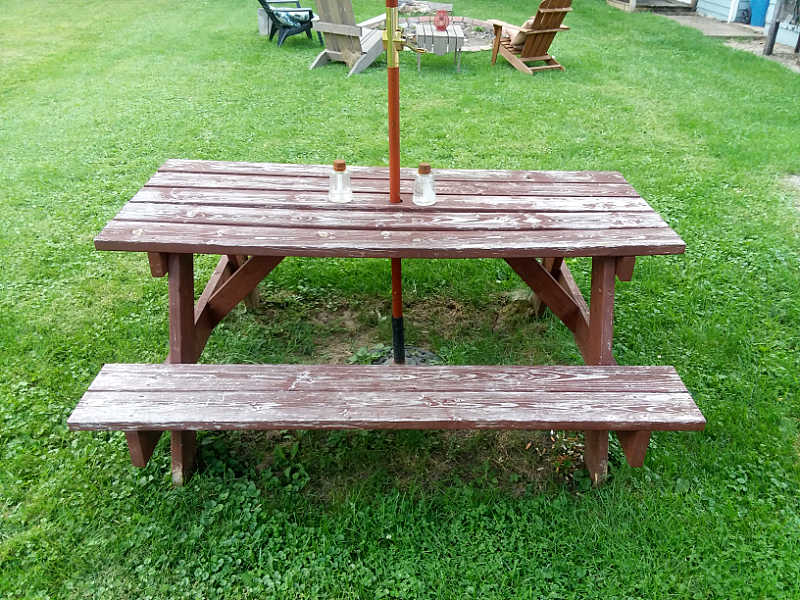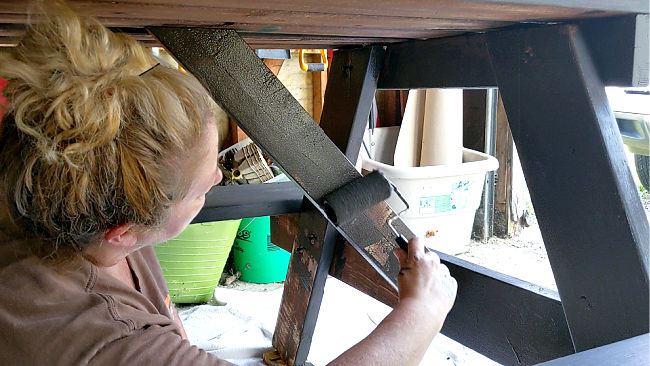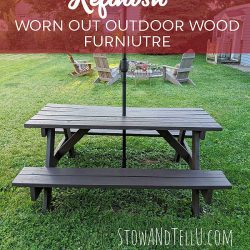Rescue and refinish outdoor wood furniture without stripping. You can easily restore most pieces with a solid stain and a lot less effort.
Since our backyard is still classified as “unfinished”, we only have a couple of pieces of outdoor wood furniture in this space, one of which is an old picnic table that has seen better days. Well, at least, I should say, the wood finish has seen better days because the table itself is still pretty sturdy (although a little warped).
They just don’t make ’em like they used to, do they?

But moving right along, about that wood finish. Can you say dry, rough, and flaky?
Kind of like my bowl of Special K cereal before I add the almond milk. Yeah, the table needed help.
And even though Ken sanded the table down to within an inch of its life (which was completely not necessary, most importantly you want a smooth finish), there was still too much of the previous stain stuck in all the nooks and crannies for me to be able to restrain it with regular non-opaque wood stain.

This is why an exterior solid (opaque) stain was the perfect choice for our several years’ old picnic table.
Many brands carry solid stain. The stain color options can range from white to black with plenty of natural-looking hues in between, including cedar, mahogany, and walnut.
If you want to refinish outdoor wood furniture with a product that is extremely easy to apply, gives full coverage, and works as an effective wood sealant to boot, I highly recommend using an exterior solid stain.
If you would prefer to use a more transparent stain, see this furniture project from Artsy Chicks Rule.
How To Restore Outdoor Wood Furniture With A Solid Stain

For this project, we happened to use the Pittsburgh Paint Oxford Brown, but as I mentioned there are quite a few brands that make a solid stain.
Below I’ll walk you through step-by-step on how to we rescued this piece.
Prepping the Wood Furniture for Stain


- Give the wood a light sanding with 120 – 150 grit sandpaper to smooth it out and remove all the loose, flaking old finish. Ken used a power sander, which is optional, but hand-sanding will also work. The idea is you want a smooth finish, but you don’t need a bare finish because the solid stain will cover the flaws.
- Rinse the table with a hose to get all the sawdust off. Allow drying time.
- Wipe the table down with a tack cloth.
Applying the Stain

- Next, working in sections, apply the stain with a small paint roller.

- Then follow that step up by brushing the stain in with a staining brush (a paintbrush that is used for staining). This step is really important because the brush will get out all the air bubbles from the roller.

Tip #1: Start at the top of the table and work your way down to the seats. Then get underneath the table and work your way outward to inward toward the underneath center of the table.
Tip #2: Be on the lookout for stain drips. These can be gently removed with a razor blade or scraping tool.
Between Coats

- Allow the stain to dry. Some of these exterior solid stain products have faster drying times. I used one that is water-based and the drying between coats was only a few hours.
- Optionally you can lightly sand the finish between coats with 400 grit sandpaper, just make sure to wipe it down with a tack cloth before applying the next coat.
- Finally, apply a second coat. Repeat the process with a third coat if needed. Our project only needed 2 coats.
As you can see, stripping the finish is not necessary to restore outdoor wood furniture. Solid stain not only gives you great coverage and protection, but it makes the job pretty darn easy.

Warping aside, this table should last a few more years until we can get an actual table set (and brick patio). But for now, the Special K effect is officially gone and this table feels and looks so much better.



Leave a Reply